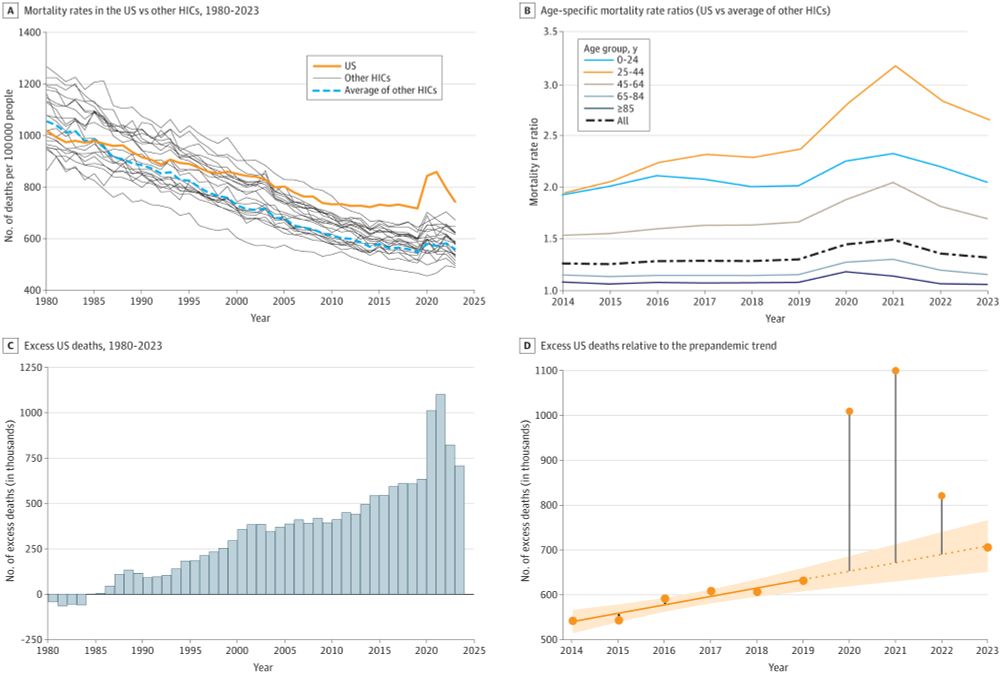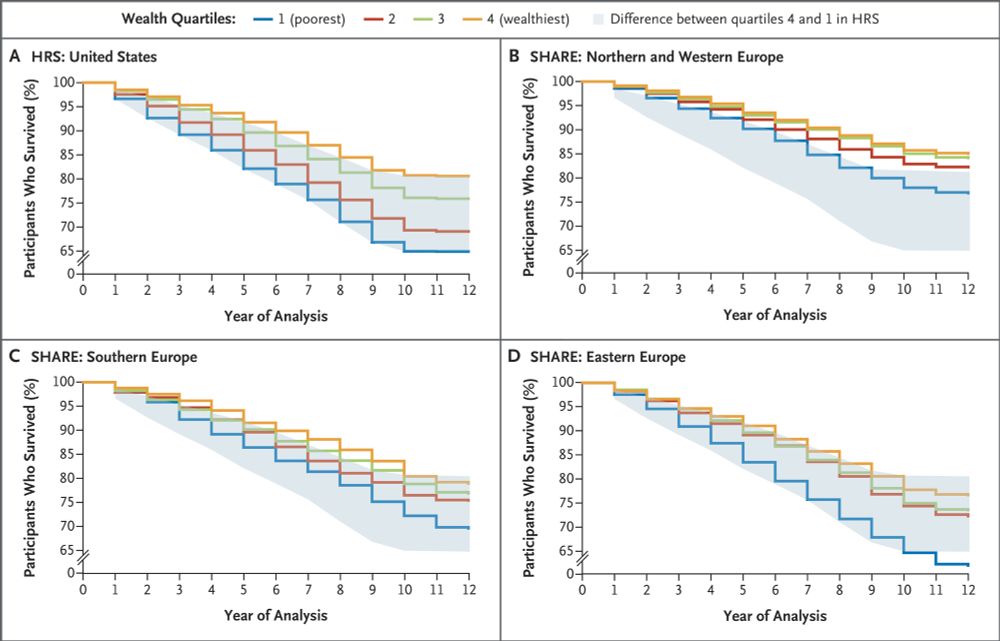Preston’s death was first labeled an overdose. The autopsy found no drugs. Likely an asthma attack amid LA’s wildfires. Our recent analysis suggests 440 excess deaths—far beyond the official 31. We’re undercounting climate’s toll. @eugeniopaglino.bsky.social
jamanetwork.com/journals/jam...
22.09.2025 17:29 — 👍 3 🔁 0 💬 0 📌 0

How many people died of COVID?
We likely undercounted, not overcounted COVID deaths
Persistent minimizing of the COVID death toll hits me especially hard in the #demography feels. To be clear:
➡️ Over one million Americans died of COVID-19.
➡️ Official COVID deaths were likely undercounted, not overcounted.
jenndowd.substack.com/p/how-many-p...
09.09.2025 11:02 — 👍 63 🔁 32 💬 4 📌 4

Millennials Are Dying at an Alarming Rate. We Have a Few Ideas as to Why.
America is not a good place to be an early adult.
As a mortality researcher, I haven’t generally paid a lot of attention to people my own age (elder Millennial here). That’s, unfortunately, changing.
(With @astokespop.bsky.social and Jacob Bor)
20.08.2025 12:25 — 👍 327 🔁 105 💬 23 📌 28

Excess Deaths Attributable to the Los Angeles Wildfires From January 5 to February 1, 2025
This study aims to estimate the number of excess deaths attributable to the Los Angeles wildfires using an interrupted time series design.
New study 🚨 out in @jama.com! We find that California wildfires🔥in January may have contributed 440 excess deaths in Los Angeles County. This estimate significantly exceeds the 30 direct fatalities linked to these events jamanetwork.com/journals/jam... @pophel.bsky.social @helsinki.fi
11.08.2025 07:40 — 👍 25 🔁 11 💬 1 📌 0

Excess Deaths Attributable to the Los Angeles Wildfires From January 5 to February 1, 2025
This study aims to estimate the number of excess deaths attributable to the Los Angeles wildfires using an interrupted time series design.
Study: 30 direct fatalities from the L.A. wildfires, but 440 deaths from January 5 to February 1, 2025 attributable to the wildfires--likely reflecting "a combination of factors, including increased exposure to poor air quality and health care delays and interruptions..." 🛟 😷 health policy
07.08.2025 04:53 — 👍 72 🔁 29 💬 1 📌 3
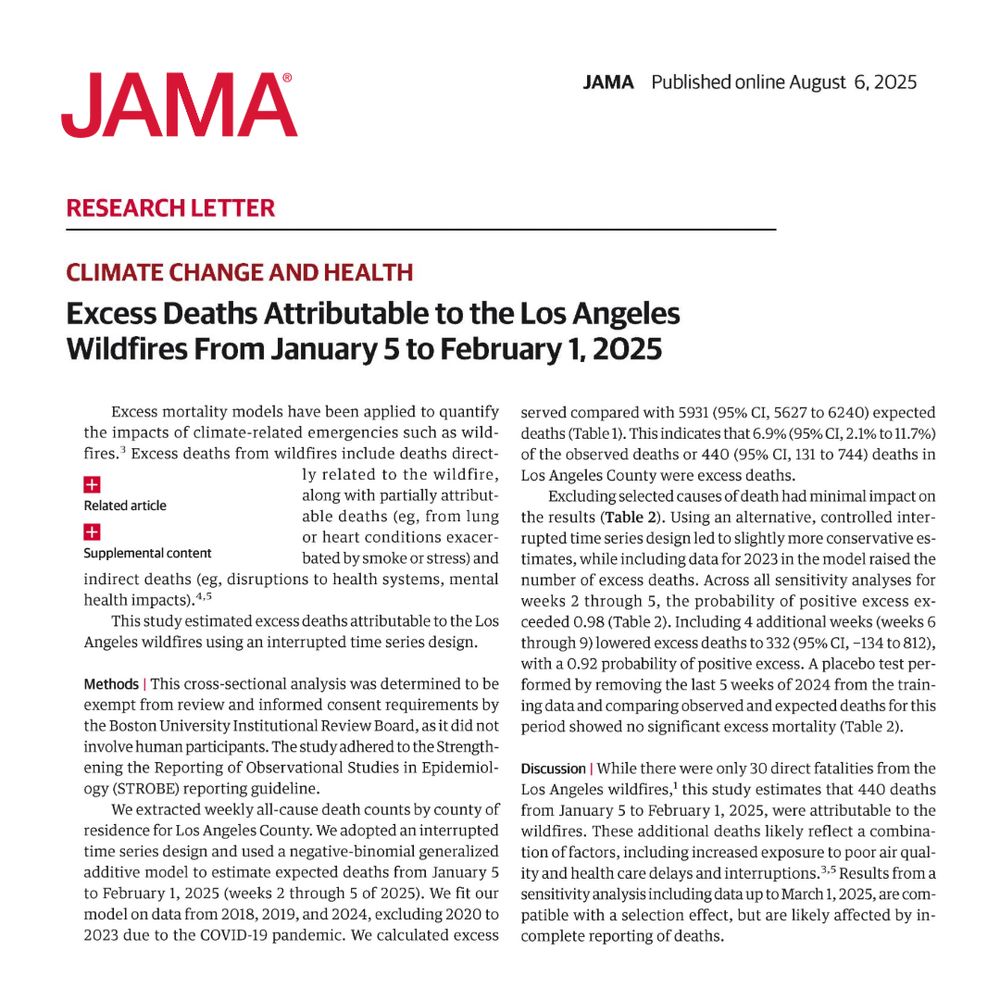
Excess Deaths Attributable to the Los Angeles
Wildfires From January 5 to February 1, 2025
An estimated 440 excess deaths were attributed to the January 2025 wildfires in Los Angeles County, underscoring indirect health effects and the need for improved mortality tracking.
ja.ma/4oFM3af #MedSky
06.08.2025 15:20 — 👍 13 🔁 7 💬 0 📌 0
NEW PAPER: "Evolution of the US nonmetropolitan mortality disadvantage by sex, state, and year, 1999‐2019" in @jruralhealth.bsky.social w/Associates Irma Elo & Samuel Preston @eugeniopaglino.bsky.social K Hempstead @astokespop.bsky.social
doi.org/10.1111/jrh....
pmc.ncbi.nlm.nih.gov/articles/PMC...
23.06.2025 18:29 — 👍 3 🔁 1 💬 0 📌 0
Education structures exposure to risk.
Adults without a BA are more likely to work unstable jobs, live in areas without access to healthy food, and face financial and logistical barriers to medical care.
These conditions increase the risk of chronic disease and premature death.
17.06.2025 11:46 — 👍 3 🔁 0 💬 1 📌 0
Adults without a BA accounted for over 260,000 excess deaths from circulatory diseases in 2023.
Diabetes was another key contributor.
Among men without a BA, nearly 1 in 3 excess deaths were from drug poisonings or other external causes.
17.06.2025 11:46 — 👍 1 🔁 0 💬 1 📌 0
Among adults without a BA, mortality in 2023 was 26% higher than expected.
For college graduates, it was 8% higher.
This divergence began before the pandemic, widened sharply during it, and persisted even after COVID deaths declined
17.06.2025 11:46 — 👍 2 🔁 0 💬 1 📌 0

Diverging Mortality Trends by Educational Attainment in the US
This cross-sectional study examines trends in US mortality rates by sex and educational attainment before, during, and after the COVID-19 pandemic.
The U.S. once saw steady declines in mortality—but progress stalled around 2010.
New research: In 2023 alone, there were 525,505 more deaths than expected had pre-2010 trends continued.
91% were among adults without a BA degree. Most were due to CVD and diabetes.
jamanetwork.com/journals/jam...
17.06.2025 11:46 — 👍 26 🔁 9 💬 2 📌 0
Thanks to The Oklahoman (www.oklahoman.com) for running my opinions on the new budget and impacts on Alzheimer's research (bit.ly/4mZXrg7) and public health progress for all of us. #PublicHealth #EndAlzheimers #Epidemiology #ScienceHomecoming
13.06.2025 15:01 — 👍 14 🔁 5 💬 1 📌 0
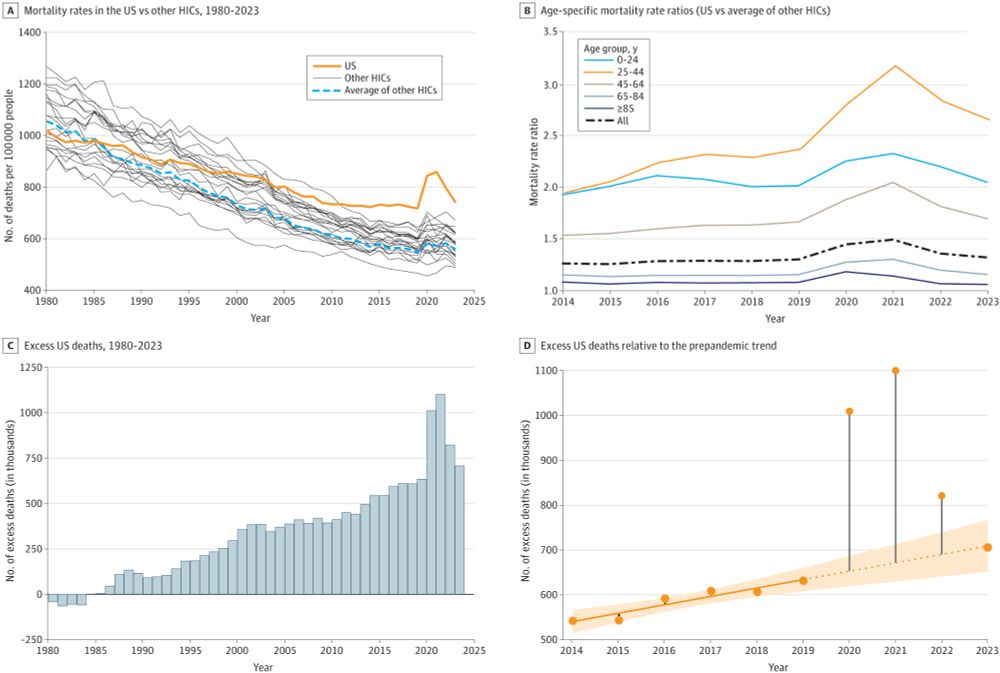
Excess US Deaths Before, During, and After the COVID-19 Pandemic
This cohort study examines trends in excess deaths in the US before, during, and after the COVID-19 pandemic.
For 40 years, Americans have lived shorter lives than people in other rich countries.
For 10 years, that's been rapidly getting worse.
New research: in 2022-2023, there were 1.5 million "missing Americans," who died--but wouldn't have, if America didn't have such uniquely high death rates.
29.05.2025 19:58 — 👍 638 🔁 295 💬 24 📌 40
Here we have calculated the number of excess deaths attributable to the US mortality disadvantage. This is based on estimates of the number of US deaths that would have been expected each year had the US population experienced the age-specific mortality rates of other wealthy nations.
27.05.2025 15:02 — 👍 4 🔁 0 💬 1 📌 0
The US mortality crisis is decades in the making—shaped by policies that fostered car-centric cities, fragmented health care, weak safety nets, and poor nutrition. These systemic failures cost lives every day—and reversing course will require bold, structural change. (4/5)
27.05.2025 14:29 — 👍 35 🔁 6 💬 1 📌 0
In 2023, 46% of all US deaths under age 65 were avoidable. That’s nearly 1 in 2 deaths in working-age adults—driven by overdoses, gun violence, car crashes, and chronic disease, rooted in policy failures and structural neglect. (3/5)
27.05.2025 14:29 — 👍 42 🔁 8 💬 1 📌 1
Since 1980, the US has accumulated nearly 15 million “missing Americans”—lives lost because our death rates remain far higher than in other wealthy nations. This crisis began long before COVID and shows no sign of slowing. (2/5)
27.05.2025 14:29 — 👍 37 🔁 6 💬 2 📌 2
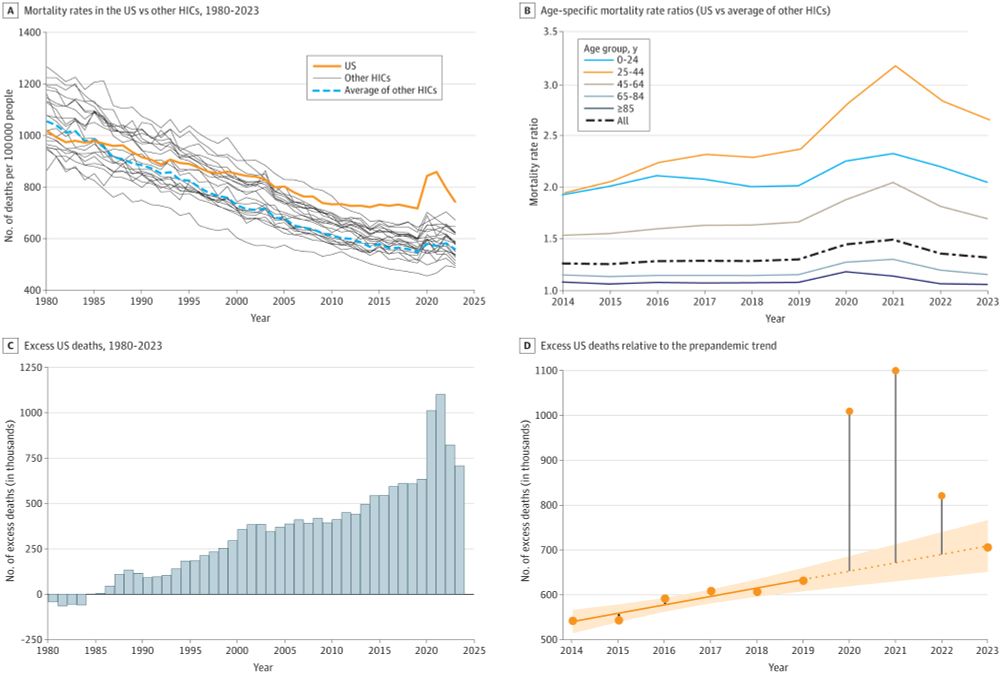
Excess US Deaths Before, During, and After the COVID-19 Pandemic
This cohort study examines trends in excess deaths in the US before, during, and after the COVID-19 pandemic.
New study with @jacob-bor.bsky.social @wrigleyfield.bsky.social & colleagues estimates that US saw 705,331 excess deaths in 2023—a number in line w/ rising pre-pandemic trend. Over 1.5 million deaths could’ve been averted in 2022–23 if US mortality matched peer nations. 🧵 (1/5)
tinyurl.com/569pr9ty
27.05.2025 14:29 — 👍 100 🔁 48 💬 3 📌 2
Three Ways of Looking at Black–White Mortality Differences in the United States | Annual Reviews
Everyone agrees that US Black deaths happen earlier than white deaths on average, but it is surprisingly challenging to find the best ways to summarize, quantify, and compare this gap. This review arg...
The biggest project I've worked on for the last chunk of years was just published. It asks, how big are US Black-white lifespan differences?
This might seem like a narrow question. I hope to convince you by the end that there are answers you didn't anticipate. And I hope some of them will move you.
30.04.2025 20:27 — 👍 444 🔁 138 💬 29 📌 6

Mortality Trends Among Early Adults in the United States, 1999-2023
This cross-sectional study examines trends in mortality rates among adults aged 25 to 44 years across the pre–COVID-19 pandemic, pandemic, and postpandemic periods.
A neat paper by @wrigleyfield.bsky.social @astokespop.bsky.social and team looks into this post 2010 period, showing that death rates from many different conditions increased relative to previous trends.
More evidence of generalized #populationhealth stressors.
jamanetwork.com/journals/jam...
05.03.2025 18:07 — 👍 21 🔁 5 💬 0 📌 0
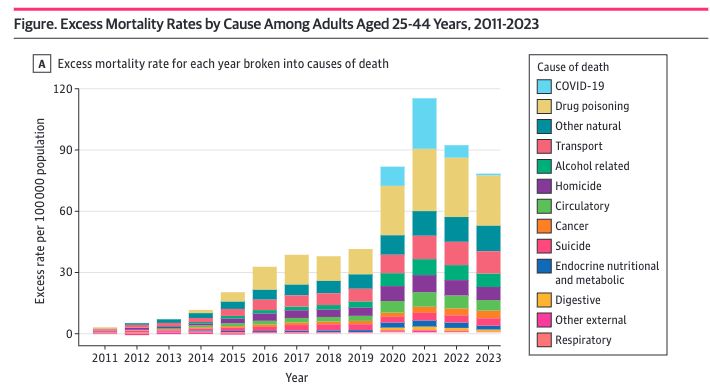
Excess mortality rates of U.S. Americans age 25-44 (relative to 1999-2010 baseline) by cause of death from @wrigleyfield.bsky.social and co-authors
from new article here: jamanetwork.com/journals/jam...
03.03.2025 17:18 — 👍 18 🔁 5 💬 3 📌 0
Thank you for writing on this study. We look forward to your insights.
11.02.2025 21:20 — 👍 0 🔁 0 💬 0 📌 0
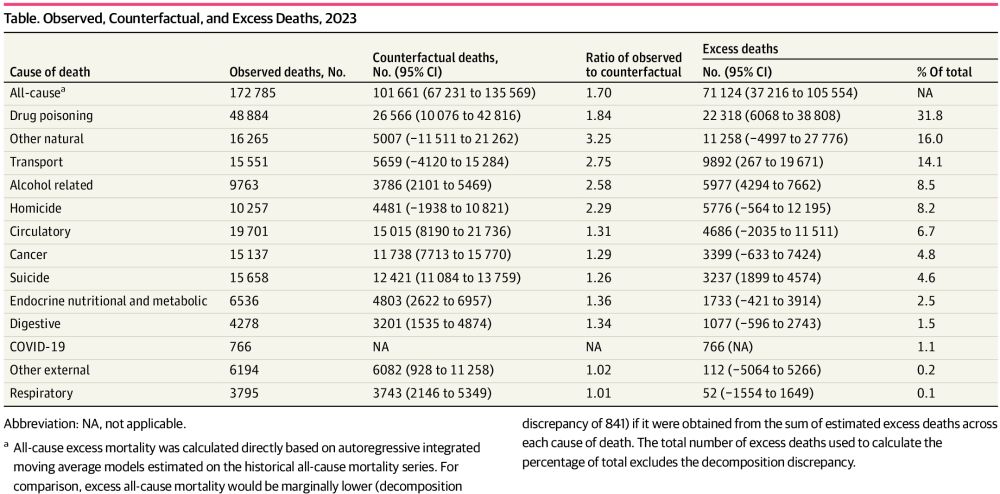
Mortality Trends Among Early Adults in the United States, 1999-2023
This cross-sectional study examines trends in mortality rates among adults aged 25 to 44 years across the pre–COVID-19 pandemic, pandemic, and postpandemic periods.
An important new study from @wrigleyfield.bsky.social, @astokespop.bsky.social and colleagues documenting high levels of excess mortality in adults ages 25-44, including from drug poisonings, transport-related deaths and homicides.
jamanetwork.com/journals/jam...
08.02.2025 15:45 — 👍 24 🔁 8 💬 0 📌 2
1/ How should public health think about new GLP-1 drugs like Ozempic? Do pharmaceutical solutions undermine public health prevention efforts?
In @milbankfund.bsky.social, Neil Mehta & I consider what new anti-obesity drugs might mean for population health.
🔗 www.milbank.org/quarterly/op...
06.02.2025 20:40 — 👍 37 🔁 12 💬 5 📌 1
A huge thanks to lead author @wrigleyfield.bsky.social and study collaborators Rafeya Raquib, Kaitlyn Berry, and Keeley J. Morris for a great collaboration. (6/6)
@minnpop.bsky.social
@busph.bsky.social
@andrewsthurston.bsky.social
@buciss.bsky.social
03.02.2025 18:05 — 👍 6 🔁 1 💬 0 📌 0
ND Econ PhD candidate ☘️
I am on the 25/26 job market.
haleywilbert.com
Director of @SNFAgoraJHU, Professor of PolSci, Director of P3 Lab @JohnsHopkins. Studying organizing, movements, civic engagement, democracy. All views my own.
#VID | Ein Institut der Österreichischen Akademie der Wissenschaften #ÖAW | Vienna Institute of Demography of the Austrian Academy of Sciences
https://www.oeaw.ac.at/vid
https://www.oeaw.ac.at/oeaw/impressum
American-Norwegian public health senior scientist and principal investigator (PI) @ Norwegian Institute of Public Health | Fertility | Cancer | Aging | Crossdisciplinary and international collaboration #AcademicSky #SciCom #EpiSky 🧪
Yale Sociologist. https://www.renealmeling.com. Books:
-Seminal: On Sperm, Health, and Politics (now out!)
-GUYnecology: The Missing Science of Men's Reproductive Health
-Sex Cells: The Medical Market for Eggs and Sperm
Now studying climate change...
Engagement Reporter @propublica.org | interested in how housing + health policies impact communities | baking, pottery + gardening | she/ella
Got tips? https://www.propublica.org/tips/
International research centre for regional development and planning located in the heart of Stockholm. We are bridging policy and research for a thriving, sustainable Nordic region and beyond.
The science of data about people. We are proud to be pioneering this science across a range of data-intensive initiatives. Find out more about us on our website https://popdatasci.swan.ac.uk
ER doc, public health professional, researcher, and former chief medical officer at the CDC. Working to improve health in communities while figuring out what is next for me
JAMA Network Open is a member of the JAMA Network, a consortium of peer-reviewed, general medical and specialty publications.
🌐 JAMANetworkOpen.com
JAMA Cardiology is a member of the JAMA Network, a consortium of peer-reviewed, general medical and specialty publications.
🌐 JAMACardiology.com
Solitary, poor, nasty, brutish and short.
science journalist @stat covering health equity, the nih, and interaction btwn science & society | also: npr, nature, sciam, science, science news (he/him) (signal: aniloza.16)
DC-based humor writer and public health data scientist; writing @ the New Yorker and other outlets. Health data nerd. PhD in public health. Writing at https://www.aliruth.com/
Ph.D. Candidate in Sociology at UC Davis
www.yaolusociology.com
PhD Candidate, Department of Sociology, McGill University
https://gvlevesque.github.io/











